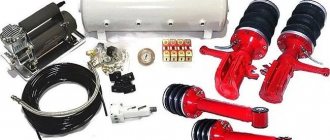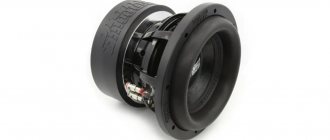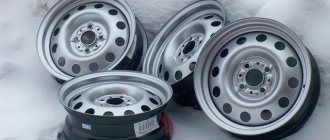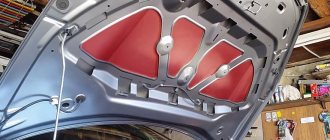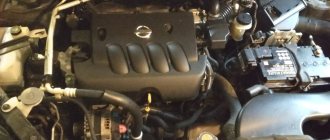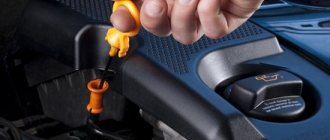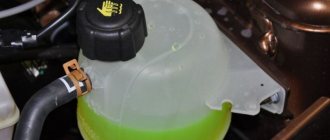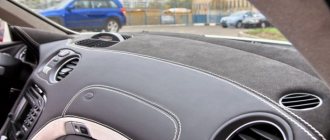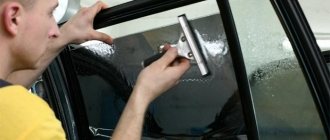What does braking distance depend on?
The indicator under consideration is not a constant value and can vary for a number of reasons. All factors influencing the braking distance can be divided into two large groups: driver-dependent and driver-independent. Reasons beyond the control of the person driving include:
It is easy to guess that in rain, snow or ice, the distance required to stop a car will be greater than on dry asphalt. Braking will also take a long time when driving on smooth asphalt, to which stone chips have not been added. Here the wheels have nothing to catch on, unlike rough surfaces.
Note: it is worth noting that poor quality of the road (potholes, potholes) does not lead to an increase in the distance required to stop. The human factor plays a role here. Trying to save the suspension, drivers rarely reach high speeds on such roads. Accordingly, the braking distance here is minimal.
Factors depending on the driver or owner of the car:
- brake condition;
- system design;
- presence of ABS;
- type of tires;
- vehicle load;
- movement speed.
Determining the speed of the car based on the obtained deformations
Only a very small number of experts determine the speed of a car in this way.
Although the dependence of car damage on its speed is obvious, there is no single effective, accurate and reproducible method for determining speed from the resulting deformations. This is due to the huge number of factors influencing the formation of damage, as well as the fact that some factors simply cannot be taken into account. The formation of deformations can be influenced by:
- the design of each specific car;
- features of cargo distribution;
- vehicle service life;
- quantity and quality of body work completed by the vehicle;
- metal aging;
- car design modifications.
Determination of speed at the moment of impact (collision)
The speed at the time of a collision is usually determined by the braking mark, but if this is not possible for a number of reasons, then approximate speed figures can be obtained by analyzing the injuries sustained by a pedestrian and the damage caused by a collision with a vehicle.
For example, the speed of a car can be judged by the characteristics of a bumper fracture - a trauma specific to being hit by a car, which is characterized by the presence of a transverse fragmentation fracture with a large fragment of bone of an irregular diamond shape on the side of the impact. Localization when hit by a bumper of a car is the upper or middle third of the lower leg, for a truck - in the thigh area.
When and how measurements are taken
Braking distance calculations may be required in the following cases:
- technical testing of the vehicle;
- checking the capabilities of the car after modifying the brakes;
- forensic examination.
As a rule, the formula S=Ke*V*V/(254*Fs) is used in the calculation. Here S is the braking distance; Ke – braking coefficient; V₀ — speed at the start of braking; Фс – coefficient of adhesion to the coating.
The coefficient of road adhesion varies depending on the condition of the surface and is determined according to the following table:
| Road condition | Fs |
| Dry | 0.7 |
| Wet | 0.4 |
| Snow | 0.2 |
| Ice | 0.1 |
The Ke coefficient is a static value and is unity for all the most common passenger vehicles.
Example: how to calculate the braking distance of a car when the speedometer shows 60 km/h in the rain? Given: speed 60 km/h, braking coefficient – 1, adhesion coefficient – 0.4. We count: 1*60*60/(254*0.4). As a result, we get the figure 35.4, which is the braking distance in meters.
The table shows how many meters the car will continue to move until it comes to a complete stop. It should be taken into account that no other indicators are taken into account (turns, potholes on the road, oncoming traffic, etc.). It is doubtful that in real conditions on an icy road, a car will be able to slide for a kilometer without encountering a pole or bump stop.
| Speed | Dry | Rain | Snow | Ice |
| km/h | meters | |||
| 60 | 20,2 | 35,4 | 70,8 | 141,7 |
| 70 | 27,5 | 48,2 | 96,4 | 192,9 |
| 80 | 35,9 | 62,9 | 125,9 | 251,9 |
| 90 | 45,5 | 79,7 | 159,4 | 318,8 |
| 100 | 56,2 | 98,4 | 196,8 | 393,7 |
| 110 | 68 | 119 | 238,1 | 476,3 |
| 120 | 80,9 | 141,7 | 283,4 | 566,9 |
| 130 | 95 | 166,3 | 332,6 | 665,3 |
| 140 | 110,2 | 192,9 | 385,8 | 771,6 |
| 150 | 126,5 | 221,4 | 442,9 | 885,8 |
| 160 | 143,9 | 251,9 | 503,9 | 1007,8 |
| 170 | 162,5 | 284,4 | 568,8 | 1137,7 |
| 180 | 182,2 | 318,8 | 637,7 | 1275,5 |
| 190 | 203 | 355,3 | 710,6 | 1421,2 |
| 200 | 224,9 | 393,7 | 787,4 | 1574,8 |
Calculation of speed during examination
To expertly determine the initial speed of a machine, specialists use the formula:
Va = 0.5*tз*j + √2Sь*j,
Where
tз – time during which the vehicle speed slows down, s;
j – deceleration constant at the moment of braking, m/s2 (determined by reference, based on GOST 25478-91);
Sу – length of the trail during braking, m.
On a dry road, j is equal to 6.8 m/s2, so the skidding speed of a car braking at a distance of 21 meters is 64.5 km/h.
After the driver begins to react to the environment, the car goes through the so-called stopping distance until the speed is completely zeroed.
So = (S1 + S2 + S3 + S4) = (t1 + t2 + 0.5*t3)*Va + Va/2j,
Where
t1 – driver reaction;
t2 – delay of the hydraulic drive of the brake system;
tз – increase in deceleration.
The time interval t4 (full stop time) is calculated as the ratio of the skidding speed Vу to the deceleration j. The time until the deceleration rate increases depends on three indicators:
- type of drive;
- road surface condition;
- vehicle weight.
To determine it, half should be subtracted from the initial speed Va until the minimum speed tз*j is established. Thus, the total time of the dynamic part of an accident for a car is t0 = t1 + t2 + t3 + t4 = T + Va/j, s.
Attention! The deceleration increase time for a pneumatic drive is longer than for a hydraulic drive. It increases with the curb weight of the vehicle and the coefficient of adhesion.
How to increase the intensity of deceleration
From the above, it became clear what is called the braking distance and what this indicator depends on. However, is it possible to reduce the distance required to stop a car? Maybe! There are two ways to do this - behavioral and technical. Ideally, the driver combines both methods.
- Behavioral method - you can reduce the braking distance if you choose a low speed on slippery and wet roads, take into account the degree of load of the car, and correctly calculate the braking capabilities of the car depending on its condition and model year. Thus, a Moskvich developed in 1985 will not be able to brake as effectively as a modern Hyundai Solaris, not to mention more respectable and technologically advanced models.
- Technical method - a method of enhancing braking capabilities, based on increasing the power of the braking system and the use of auxiliary mechanisms. Manufacturers of modern vehicles actively use such methods of improving brakes, equipping their products with anti-lock braking systems, braking assistance systems, using more efficient brake discs and pads.
It should be remembered that reducing the time required to stop is one of the ways to ensure a safe trip. Therefore, every driver must constantly monitor the technical condition of his “iron horse”, promptly maintain and repair the braking system. In addition, it is important to choose the driving speed taking into account the surrounding situation: time of day, road condition, car model, etc.
so UNT / Traffic rules / Lesson plans for traffic rules 6th grade
Lesson No. 3 Topic: “Braking and stopping distance of vehicles”
26.09.2013 30574 0
Goals and objectives of the lesson:
creating a sense of danger when crossing the roadway in front of nearby vehicles; familiarizing students with the concepts of braking and stopping distance, danger zone.
Materials for the lesson:
Let's imagine that we all have a license to drive a car, that we are drivers. We get behind the wheel, turn on the ignition, start the engine. Go. We're driving down the street. The weather is clear, the asphalt is dry, the mood is excellent. We are not daredevil racers, but ordinary experienced drivers.
The speedometer needle, shaking, shows: 20, 30, 40. We are driving at a speed of 40 km/h - this is a sufficient and quite moderate speed for driving around the city in a passenger car. You can’t say anything: it’s nice to sit behind the wheel and drive the car. We carefully monitor the road, and also look at the sidewalk - from there an inattentive pedestrian can unexpectedly jump out onto the pavement. And suddenly a boy runs out onto the road, right in front of our car. We press the brake pedal... From the moment the driver notices the danger until the moment he presses the brake pedal, some time passes, which is called the driver's reaction time
(RA).
This time is very short and may seem insignificant, but it is of great importance. In a healthy person it is 0.8-1.0 seconds. While the human brain “telegraphs”—instructs the leg to stop—the car moves on. This is the distance traveled
by the car
during the driver's reaction time
(RT).
From the moment you press the brake pedal, the wheels begin to rotate more slowly, even stopping, but the car has not stopped yet. The path a car travels from the start of braking to a complete stop is called the braking path
or
braking distance
(PT).
stopping distance
And the path that a car travels from the moment the driver notices the danger until it comes to a complete stop is called stopping distance
(PTL).
Thus, stopping distance (PTL) = distance covered during the driver's reaction time (RT) + braking distance (PT).
РТL = RT + РТ
Fortunately, the boy escaped with fright; he turned pale and was ready to cry. It's good that it is so. One of the eyewitnesses managed to call the ambulance station (phone 03) and the police department (phone 02), and soon an ambulance rushed with the siren on, followed by a traffic inspector. The doctor examined the boy and found no injuries or even scratches.
The traffic inspector wrote down the boy's name, school number, home address and sent him home.
But everything could have ended differently. How? (Students list all the possible consequences of the boy’s action).
The boy could have been injured and could have remained disabled. To avoid hitting the boy, the driver could turn right or left, being unable to stop the car, drive onto the sidewalk and hit pedestrians. The driver could veer off the road, hit a pole or building, get injured, etc.
But the work of the traffic inspector at the scene did not end there. Or rather, it has just begun. It was necessary to establish how fast the car was traveling and whether the driver adhered to the traffic rules. First, the traffic inspector measured the brake mark.
When investigating the causes of a traffic accident, this is the most important thing, because the braking distance can be used to determine the speed of the car.
The length of the braking mark was 12 meters. This is the stopping distance
, the distance the car has traveled from the start of braking to a complete stop. Then the traffic inspector took out a table from the folder, calculated it and told the driver that he was driving at a speed of 40 km/h. And he noticed the boy on the road 20-25 meters away. How did he know this? We'll do the math too.
Let us remember that the braking distance (PT) + the distance covered during the driver's reaction time (RT) = stopping distance (PTL). We already know the length of the braking distance; it is 12 meters. You need to find out the length of the path covered during the driver's reaction time. Let's assume that the driver's reaction time is 1 second. How many meters will a car travel in one second if its speed is 40 km/h?
1 hour is 60 minutes, 1 minute is 60 seconds, which means 1 hour = 3600 seconds.
1 kilometer = 1000 meters, 40 kilometers = 40,000 meters.
40000 :
3600 = 11.1 meters. This is the distance covered during the driver's reaction time (RT).
And the stopping distance length (PTL):
12 m + 11.1 m = 23.1 m.
At a distance of 23.1 meters, the driver saw a boy running. If he had noticed it at a shorter distance, the consequences would have been sad, misfortune would have become inevitable. When driving on a flat, dry asphalt road at a speed of 40 km/h, the driver of a passenger car is able to stop the car 23 meters after he notices the danger. This distance is called the danger zone
, no one can get here.
Each moving vehicle has its own danger zone
in front of the car, the length of this zone depends on:
— vehicle speed;
— from the weight of the car;
— on the track profile (evenness, presence of ascents and descents);
- on the condition of the coating and the quality of the tread on the tires.
Driving speed and danger zone
The higher the speed of the car, the longer the distance it travels in one second. As speed increases, the first thing that increases is the distance the car travels during the driver’s reaction time. The higher the speed, the greater the force developed in the wheels, the longer the braking distance and the danger zone.
Length of the danger zone in meters on a dry asphalt road at various car speeds:
| Speed (km/h) | Distance traveled in 1 second of driver reaction time (RT) (m) | Braking distance (RT) (m) | Danger zone (PTL) (RT + RT) (m) |
| 10 | 2,8 | 0,8 | 3,6 |
| 30 | 8,3 | 7,2 | 15,5 |
| 50 | 13,9 | 19,6 | 33,5 |
| 60 | 16,7 | 28,4 | 45,1 |
| 80 | 22,2 | 43,2 | 65,4 |
| 100 | 27,8 | 78,7 | 106,5 |
| 120 | 33,3 | 113,0 | 146,3 |
If the speed doubles, the danger zone increases at the same time three times.
This means that crossing the road in front of an approaching car is dangerous.
You should never think: “Nothing, I’ll have time...” and then start crossing the road. If, for example, a passenger car is approaching at a speed of 60 km/h, then crossing the street 50 meters from it is already risky; you may find yourself on the border of a danger zone. It is safe to cross the road only when there is a distance equal to the length of two danger zones to the approaching car.
Naturally, it is difficult for a pedestrian to accurately determine the speed of an approaching car and calculate the length of the danger zone. No pedestrian is capable of this, so you should “err” in your favor when estimating the distance to the approaching car. This is the best way and a guarantee of safety.
It is especially difficult to determine the distance of an approaching car and its approximate speed at dusk, in the dark, in fog, in rain and snowfall. At dusk and in the dark, visibility deteriorates significantly. Pedestrians and drivers are not very good at distinguishing what is happening on the road. In the dark, it is easy to make a mistake in determining the distance both to a moving car and to stationary objects. In poor lighting, close objects often appear far away, and distant objects appear close. Visual illusions occur: a stationary object can be mistaken for moving, a moving object for an approaching one, and vice versa. In the dark, it is difficult to determine by the light of a car's headlights whether it is approaching or not. And if it is approaching, then at what speed?
Human eyes are designed in such a way that they need time to get used to the dark. But still, night vision is significantly worse than day vision.
In poor lighting, at dusk, the eyes have difficulty distinguishing colors. For example, red appears dark and even black. Green appears lighter than red. When approaching a traffic light, its signals initially appear white, and only later do we begin to distinguish colors. First of all, green becomes visible, then yellow and red. Unfortunately, not all pedestrians and drivers know this and do not exercise due caution in the dark.
The conclusion is simple. In the dark, when crossing the street, the distance to an approaching car should be greater than during the day. You can’t rush during the day, and even more so in the dark. It is advisable not to wear dark clothes in the dark. If possible, you should use reflective stickers, clothing tapes and badges that help drivers see you from a long distance.
This is how much a driver needs to know and take into account when choosing the speed of his car, and a pedestrian - when determining the distance to an approaching car if he needs to cross the road.
When the driver chooses the driving speed, he knows the technical condition of his car and his capabilities. Therefore, he also knows the length of the car’s braking distance.
The pedestrian does not know the technical condition of the approaching car, nor what physical condition the driver is in, what his skills and experience are.
This means that for a pedestrian, when crossing the road, it is very important to choose the right distance to an approaching car or other vehicle. You cannot cross the road in places where the driver does not expect a pedestrian to appear on the roadway, i.e. where there is no pedestrian crossing. A pedestrian must know where and how to cross the road, and follow these rules very precisely.
Vehicle weight and danger zone
The greater the mass of the vehicle, the greater its energy. Therefore, it turns out that at the same speed, different vehicles have different braking distances, and, consequently, a dangerous zone. In a truck, the weight of the load plays a role, because a vehicle without a load is easier to stop than a loaded one. The load increases the stopping distance of a truck by approximately one third
Road surface condition and danger zone
The condition of the pavement has the greatest influence on the length of the braking distance. The rougher the road surface, the better the grip of the wheels on the road. When the wheels begin to rotate more slowly when braking, there is no danger of slipping. For braking, this circumstance is of great importance. Our roads are covered with asphalt concrete, asphalt, crushed stone and gravel. They have different degrees of roughness. Drivers like the most asphalt covered with crushed stone. Smooth asphalt is much worse. Asphalt covered with crushed stone can be compared to sandpaper, and smooth asphalt can be compared to ordinary paper, say, a sheet from a notebook. Try running your finger over the sandpaper. Somehow the grip of the fingers with the paper occurs on its own. It's a different matter with smooth paper. Fingers slide on the paper, grip is much worse. The situation is exactly the same with the grip of tires and the road on different surfaces.
Meteorological conditions have a particularly great influence on the condition of the coating. Tires have the best grip on the road when the surface is dry. Grip greatly deteriorates when the surface is wet.
The onset of rain is especially deceptive and poses a great danger to drivers and pedestrians. The first drops of rain that fall on the road mix with dust and cover the road with a slimy layer. This significantly worsens the traction of the tires to the road, driving the car is difficult, the car can skid when turning, and a sharp turn of the steering wheel can cause a side slip.
When it starts to rain, motorcyclists find themselves in the most dangerous situation. The two-wheeled motorcycle becomes difficult to control, the wheels begin to slip, and the motorcycle may tip over. After some time, the rain will wash away the mucous layer from the road, and the tires’ grip on the road will improve slightly, but will still not be as good as before. Why?
The thing is that when a car wheel rotates, it cannot completely displace the water that has entered the tread grooves. A layer of water remains between the tire and the road surface; the car rides as if on a cushion of water and is therefore unstable. When driving fast, the car seems to float on the road. This phenomenon is called aquasliding. It is essentially similar to water skiing. The incredible power of a raindrop on the road. It will make even the heaviest truck slide. The more worn the tires are, the more likely they are to skid.
A road with compacted snow and especially ice is several times more dangerous than a wet road. The braking distance here increases especially sharply.
Rain, snow and ice are unwelcome companions for the driver. The braking distance, as well as the danger zone, increases by two times on a packed snow road, and by five times on ice. Stopping a car in winter is much more difficult than in summer.
Careless pedestrians cause a lot of trouble for drivers. It seems to them that it is just as easy to stop a car in winter as in summer. We have already explained that this is not so. The danger zone in front of the car is now increased several times. And an inattentive pedestrian, who doesn’t care about all this, crosses the road in front of a car, which, as it seems to him, is still quite far away. The driver instinctively presses the brake pedal. But since the adhesion of the wheels to the road is poor, the wheels stop rotating, become blocked, and the car slides further like a sled, not obeying the steering wheel control.
Every pedestrian must understand that any of his actions, no matter how insignificant, as it seems to him, can cause a dangerous situation. It’s easy to prevent this - let’s all be truly attentive and polite! And in traffic the word “please” is applicable. Let's put it into practice!
Review questions
1. Why is it impossible to stop a car instantly?
2. What is stopping distance?
3. What is the distance traveled during the driver’s reaction time?
4. What is a danger zone?
5. One car is traveling at a speed of 10 km/h, and the other is traveling at 30 km/h. Which one will stop first if the drivers brake at the same time?
6. Why shouldn’t you cross the road in front of an approaching car?
7. When and in what case is it easier to stop a car: in summer or winter, on a dry or wet road?
8. Do you think that a pedestrian and a cyclist also have a braking distance?
9. If a truck and a car are traveling at the same speed, which one will stop first after braking?
10. How many times does the danger zone increase in winter compared to a dry road in summer?
11. From Tallinn to Narva 216 kilometers. How many hours will it take a motorcyclist to cover this distance if he travels at a speed of 60 km/h (one kilometer per minute)?
12. Why is driving at high speed dangerous?
Formulas for calculating stopping and braking distances, as well as safe distances.
In the theory exam there is a question about the average reaction time of a driver, the correct answer to which is 1 second. The traffic police tickets also contain a question related to safe distance. There are questions regarding braking. But, as they say, a theory is a theory, which, alas, as a rule, has nothing in common with practice.
Firstly, what you taught in the tickets is a theory based on averages and various studies. In fact, the driver's reaction time, stopping and braking distance depend on many factors and cannot be accurately calculated for all cases. Nevertheless, every driver should be able to calculate these parameters at least approximately.
Types of braking
It is also worth considering that the method of braking plays a big role:
- A sharp press can send the car into an uncontrolled skid.
- Gradually pressing the pedal will work if there is good visibility and time to spare, but it cannot be used in an emergency situation.
- Intermittent braking with several presses of the pedal to the stop will allow you to quickly stop the car, but is also fraught with loss of control.
- Pressing in steps will allow you to lock the wheels without losing contact with the pedal.
In winter conditions, ABS will increase the braking distance by 15-30 meters when driving on snow or ice. At the same time, the system will leave the driver control of the car, which can be critically important when driving on ice.
Friction table at different speeds
Remember, the weak points of ABS are muddy soil and clay. The braking distance may also be longer with them than with fully “manual” braking. But control over the car will also remain.
Car braking distance
Braking distance is the distance that the vehicle will travel between the driver's contact with the brake pedal and the vehicle coming to a complete stop. It is also worth understanding the differences between “normal braking” and “emergency braking”. In particular, we must not forget that weather conditions affect braking distances. If there is snow on the road, the braking distance naturally increases.
Here is the formula for calculating the braking distance:
Calculation example: imagine that you are driving at a speed of 50 km/h in the city and approach a pedestrian crossing along which children are walking. Calculation: (50 km/h : 10) x (50 km/h : 10) = 25 (meters). Thus, the braking distance of your car is 25 meters. Therefore, you must take into account the length of the braking distance in order to calmly start braking in a timely manner and stop before the pedestrian crossing.
Where does the brake fluid go - sources of leakage?
Crack in the brake fluid reservoir
First of all, inspect the tank itself, this may be the reason. Do not rush to immediately disassemble the floor of the car in order to find the cause of the brake fluid leak. In general, it is best to look for the source of the malfunction by following the characteristic traces of leakage; they will show you the location, as well as the cause of the leakage of the fuel fluid.
Violation of the integrity of the brake cylinder
If your brake cylinder is leaking, the fuel fluid level will constantly drop, and under the car after long periods of inactivity, as a rule, there will be stains of fuel fluid on the asphalt. In order to confirm or refute this assumption, it is necessary to perform an inspection. To do this, remove the wheels and carry out a visual inspection of the front discs, check for any leaks on the calipers. If you have drum brakes on the rear wheels, you will also have to remove the drums. A leak in the rear brake cylinder is most often associated with damage to the rubber seals; they may be of poor quality or cracked over time. In winter, this problem is very urgent, the seals “dull” and leakage of fuel fluid occurs.
Damage to the brake hose
To establish this malfunction, a visual inspection will also be sufficient; you can touch the hoses with your hands to make sure they are in good condition. If the hoses feel hard to the touch or crack when bent, replace the hoses with new ones. Check for leaks on the hoses; they must be completely dry. Sometimes it happens that the brake hose simply flies off the fitting, in which case you need to put it in place and secure it using special clamps or replace the hose with a similar one, only of a smaller diameter.
The main brake cylinder (GTC) is faulty
In this case, it is necessary to inspect the gas turbine housing; in most cases, the leak occurs precisely because of the seal. A crack may form in the rubber seal, which causes fuel fluid leakage. Other scenarios are also possible, for example, when the brake fluid goes into the “vacuum reservoir”, while there are no signs of leakage outside; in order to detect this malfunction, it is necessary to remove the brake master cylinder. After removing the brake cylinder, remove it from the “vacuum chamber”, if you find a leak inside the “vacuum chamber” - completely replace the entire brake cylinder.
Start the engine, put it in neutral and apply the brake. If the cause of the brake fluid leak is in the hydraulic drive, the pedal will gradually “fail”. If you press the brake pedal and it reaches almost to the floor, the problem will be associated with a malfunction of the brake circuit.
After completing all repair work, it is MANDATORY to bleed the brake system. Also consider the fact that brake fluid is hygroscopic, so it must be changed after a certain period of time.
Issues discussed in the material:
- Where does the brake fluid go?
- How to detect a leak
- How to fix a brake fluid leak yourself
- Is it possible to get to your destination if brake fluid leaks on the road?
The braking system of a car operates using brake fluid (BF). An expansion tank is provided for it, on the body of which there are marks, by which you can find out what the volume of fluid is in the brake system. The lowest permissible level is marked min, and the highest, accordingly, is marked max. The brake system will operate normally when the fluid level is between these two marks. Some drivers prefer to add brake fluid to the maximum value.
If you see that its level drops sharply, and brake fluid leaks are found on the wheels, this is a signal to urgently take action; driving a car with such a malfunction becomes dangerous.
Driver reaction time and path
Driver reaction time is the time that will pass from the moment the driver detects a danger on the road until the start of taking measures to prevent it.
The driver's reaction path is the distance the vehicle will travel from the moment the driver detects a hazard on the road until the brake pedal is pressed.
Here is the formula for calculating the distance a car will travel when the driver reacts to danger:
(Speed in km/h: 10) x 3 = reaction distance in meters
Calculation example: imagine that you are driving at a speed of 100 km/h along a country road and suddenly an elk runs out onto the road. Calculation: (100 km/h: 10) x 3 = 30 (meters). That is, after you react to a danger on the road, your car will travel about 30 meters. Add to this the braking distance of the car.
Attention: these rules are not scientifically correct formulas and provide only approximate values!
Traffic rules and speed
In order to keep the braking distance as short as possible and in accordance with the table above, you should adhere to the traffic rules and recommended speed.
- So, in populated areas you should not exceed the speed of more than 60 kilometers per hour, and in courtyards and residential areas you should not drive more than twenty kilometers per hour.
- For buses carrying children, there is a limit on all roads - sixty kilometers per hour.
- The same speed conditions must be observed for vehicles that have people sitting on special benches in the back. Buses, whether intercity or small, as well as motorcycles are allowed to travel no more than 90 kilometers per hour.
- All other buses, as well as category “B” cars that tow a trailer , can drive no more than 90 kilometers per hour on highways.
- The same rules apply to semi-trailer trucks. But on other roads these vehicles can travel no more than 70 kilometers per hour.
- Cars and trucks (if the gross weight does not exceed three and a half tons) can drive on highways at a speed of 110 kilometers per hour, and on all other roads - no more than 90 kilometers per hour.
Car stopping distance
Stopping distance is the distance traveled by a vehicle from the moment the driver detects a danger on the road until the car comes to a complete stop.
If you want to calculate a car's stopping distance, you must add to the car's braking distance the distance covered during the driver's reaction time. Here's how to do it:
The first value in the expression is the driver reaction path traveled by the car while the driver is reacting to a hazard on the road. The second expression is the formula for calculating the braking distance. In order to calculate the stopping distance of the vehicle, it is necessary to add both results together.
Calculation example: you are driving your car at a speed of 50 km/h. Calculation: (50 km/h : 10) x 3 = 15 meters of distance the car will travel when responding to a danger on the road (50 km/h : 10) x (50 km/h : 10) = 25 meters will be the braking distance of the car. As a result, adding both values, we find that the stopping distance of the vehicle will be 40 meters.
Attention: these rules are not scientifically correct formulas and provide only approximate values!
Brake system and its features
Each vehicle has its own time to stop. The brake system in the car sections works almost the same, the only difference is in the condition of the brake pads.
A certain vehicle will be able to stop for:
- Passenger cars – 12-13 seconds.
- Buses up to 5 tons – 13-14 seconds.
- Buses over 5 tons – 16-17 seconds.
- Trucks up to 3.5 tons – 15-16 seconds.
- Trucks from 3.5 to 12 tons – 17-18 seconds.
- Trucks weighing more than 12 tons – 17-18 seconds.
- Two-wheeled mopeds or motorcycles – 7-8 seconds.
- Motorcycle equipped with a trailer – 8-9 seconds.
- Passenger cars with a trailer – 13-14 seconds.
Distance
- Three car lengths . Anyone traveling in urban areas must maintain a distance of at least 15 meters, or three car lengths.
- Half speedometer : for a safe distance outside of populated areas, pay attention to the speed of the car. In order to calculate a safe distance, divide by 2 the current speed shown by the speedometer. As a result, you will get the distance to other cars in meters. Example: At a speed of 70 km/h, you must keep at least 35 meters from the vehicle in front. Moreover, this applies to dry asphalt in the summer.
- Double distance : In case of poor visibility or bad road conditions, you should double the safe distance.
Braking in different conditions
The length of the braking distance is inversely proportional to the coefficient of adhesion to the road. Simply put, the worse the road holds, the longer the car slows down. Let's look at the changes in the coefficient (Fs) in more detail:
- with dry asphalt - 0.7;
- on wet asphalt - 0.4;
- if the snow is rolled - 0.2;
- icy road - 0.1.
These numbers allow us to see how stopping distances will change depending on conditions. As already mentioned, at a speed of 60 km/h on a dry road the car will brake in 20.25 meters, and on ice - 141.7. On a wet track the braking distance will be 35.4 meters, and on a snowy track - 70.8.


